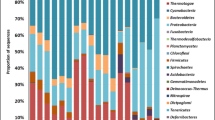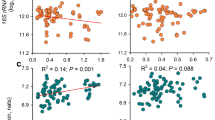Abstract
Nickel pollution imposes deleterious effects on soil ecosystem. The responses of soil microorganisms to long-term nickel pollution under field conditions remain largely unknown. Here, we used high-throughput sequencing to elucidate the impacts of long-term nickel pollution on soil bacterial communities in two contrasting agricultural soils. Our results found that the soil microbial biomass carbon consistently decreased along the nickel gradients in both soils. Nickel pollution selectively favored or impeded the prevalence of several dominant bacterial guilds, in particular, Actinobacteria showed tolerance, while Acidobacteria and Planctomycetes displayed sensitivity. Despite the apparent shifts in the bacterial community composition, no clear tendency in the bacterial diversity and abundance was identified along the nickel gradients in either soil. Collectively, we provide evidence that long-term nickel pollution shifted the soil bacterial communities, resulting in the decrease of microbial biomass although the bacterial diversity was not significantly changed.






Similar content being viewed by others
References
Adamo P, Dudka S, Wilson MJ, McHardy WJ (1996) Chemical and mineralogical forms of Cu and Ni in contaminated soils from the Sudbury mining and smelting region Canada. Environ Pollut 91:11–19
Ager D, Evans S, Li H, Lilley AK, van der Gast CJ (2010) Anthropogenic disturbance affects the structure of bacterial communities. Environ Microbiol 12:670–678
Awasthi A, Singh M, Soni SK, Singh R, Kalra A (2014) Biodiversity acts as insurance of productivity of bacterial communities under abiotic perturbations. ISME J 8:2445–2452
Bååth E, Frostegård Å, Pennanen T, Fritze H (1995) Microbial community structure and pH response in relation to soil organic matter quality in wood-ash fertilized, clear-cut or burned coniferous forest soils. Soil Biol Biochem 27:229–240
Bardgett RD, Lovell RD, Hobbs PJ, Jarvis SC (1999) Seasonal changes in soil microbial communities along a fertility gradient of temperate grasslands. Soil Biol Biochem 31:1021–1030
Bates ST, Berg-Lyons D, Caporaso JG, Walters WA, Knight R, Fierer N (2011) Examining the global distribution of dominant archaeal populations in soil. ISME J 5:908–917
Berg J, Brandt KK, Al-Soud WA, Holm PE, Hansen LH, Sørensen SJ, Nybroe O (2012) Selection for Cu-tolerant bacterial communities with altered composition, but unaltered richness, via long-term Cu exposure. Appl Environ Microbiol 78:7438–7446
Caporaso JG, Kuczynski J, Stombaugh J, Bittinger K, Bushman FD, Costello EK et al (2010a) QIIME allows analysis of high-throughput community sequencing data. Nat Methods 7:335–336
Caporaso JG, Bittinger K, Bushman FD, DeSantis TZ, Andersen GL, Knight R (2010b) PyNAST: a flexible tool for aligning sequences to a template alignment. Bioinformatics 26:266–267
Cempel M, Nikel G (2006) Nickel: a review of its sources and environmental toxicology. Polish J of Environ Stud 15:375–382
Chen X, Zhang LM, Shen JP, Xu ZH, He JZ (2010) Soil type determines the abundance and community structure of ammonia-oxidizing bacteria and archaea in flooded paddy soils. J Soil Sediment 10:1510–1516
Edgar RC (2013) UPARSE: highly accurate OTU sequences from microbial amplicon reads. Nat Methods 10:996–998
Falkowski PG, Fenchel T, Delong EF (2008) The microbial engines that drive Earth’s biogeochemical cycles. Science 320:1034–1039
Field D, Tiwari B, Booth T, Houten S, Swan D, Bertrand N, Thurston M (2006) Open software for biologists: from famine to feast. Nat Biotechnol 24:801–804
Fierer N, Jackson RB (2006) The diversity and biogeography of soil bacterial communities. PNAS 103:626–631
Fierer N, Schimel JP, Holden PA (2003) Influence of drying–rewetting frequency on soil bacterial community structure. Microb Ecol 45:63–71
Fierer N, Ladau J, Clemente JC, Leff JW, Owens SM, Pollard KS, Knight R, Gilbert JA, McCulley RL (2013) Reconstructing the microbial diversity and function of pre-agricultural tallgrass prairie soils in the united states. Science 342:621–624
Fuerst JA, Sagulenko E (2011) Beyond the bacterium: Planctomycetes challenge our concepts of microbial structure and function. Nat Rev 9:403–413
Giller KE, Witter E, McGrath SP (1998) Toxicity of heavy metals to microorganisms and microbial processes in agricultural soils: a review. Soil Biol Biochem 30:1389–1414
Griffiths BS, Philippot L (2012) Insights into the resistance and resilience of the soil microbial community. FEMS Microbiol Rev 37:112–129
Guo XY, Zuo YB, Wang BR, Li JM, Ma YB (2010) Toxicity and accumulation of copper and nickel in maize plants cropped on calcareous and acidic field soils. Plant Soil 333:365–373
Haferburg G, Kothe E (2007) Microbes and metals: interactions in the environment. J Basic Microbiol 47:453–467
He JZ, Shen JP, Zhang LM, Zhu YG, Zheng YM, Xu MG, Di HJ (2007) Quantitative analyses of the abundance and composition of ammonia-oxidizing bacteria and ammonia-oxidizing archaea of a Chinese upland red soil under long-term fertilization practices. Environ Microbiol 9:2364–2374
He JZ, Zheng Y, Chen CR, He YQ, Zhang LM (2008) Microbial composition and diversity of an upland red soil under long-term fertilization treatments as revealed by culture-dependent and culture-independent approaches. J Soil Sediment 8:349–358
He JZ, Ge Y, Xu ZH, Chen CR (2009) Linking soil bacterial diversity to ecosystem multifunctionality using backward-elimination boosted tree analysis. J Soil Sediment 9:547–554
He JZ, Hu HW, Zhang LM (2012) Current insights into the autotrophic thaumarchaeal ammonia oxidation in acidic soils. Soil Biol Biochem 55:146–154
Héry M, Nazaret S, Jaffré T, Normand P, Navarro E (2003) Adaptation to nickel spiking of bacterial communities in neocaledonian soils. Environ Microbiol 5:3–12
Hu HW, Zhang LM, Dai Y, Di HJ, He JZ (2013) pH-dependent distribution of soil ammonia oxidizers across a large geographical scale as revealed by high-throughput pyrosequencing. J Soil Sediment 13:1439–1449
Hu HW, Xu ZH, He JZ (2014) Ammonia-oxidizing archaea play a predominant role in acid soil nitrification. Adv Agron 125:261–302
Jones RT, Robeson MS, Lauber CL, Hamady M, Knight R, Fierer N (2009) A comprehensive survey of soil acidobacterial diversity using pyrosequencing and clone library analyses. ISME J 3:442–453
Khan S, Hesham AE, Qiao M, Rehman S, He JZ (2010) Effects of Cd and Pb on soil microbial community structure and activities. Environ Sci Pollut Res 17:288–296
Lauber CL, Hamady M, Knight R, Fierer N (2009) Pyrosequencing-based assessment of soil pH as a predictor of soil bacterial community structure at the continental scale. Appl Environ Microbiol 75:5111–5120
Lejon DPH, Pascault N, Ranjard L (2010) Differential copper impact on density, diversity and resistance of adapted culturable bacterial populations according to soil organic status. Eur J Soil Biol 46:168–174
Li J, Zheng YM, Liu YR, Ma YB, Hu HW, He JZ (2014) Initial copper stress strengthens the resistance of soil microorganisms to a subsequent copper stress. Microb Ecol 67:931–941
Liu YR, Zheng YM, Shen JP, Zhang LM, He JZ (2010) Effects of mercury on the activity and community composition of soil ammonia oxidizers. Environ Sci Pollut Res 17:1237–1244
Ma YB, Lombi E, Oliver IW, Nolan AL, Mclaughlin MJ (2006) Long-term aging of copper added to soils. Environ Sci Technol 40:6310–6317
Macdonald CA, Singh BK, Peck JA, van Schaik AP, Hunter LC, Horswell J, Campbell CD, Speir TW (2007) Long-term exposure to Zn-spiked sewage sludge alters soil community structure. Soil Biol Biochem 39:2576–2586
Macdonald CA, Clark IM, Zhao FJ, Hirsch PR, Singh BK, McGrath SP (2011) Long-term impacts of zinc and copper enriched sewage sludge additions on bacterial, archaeal and fungal communities in arable and grassland soils. Soil Biol Biochem 43:932–941
Magoè T, Salzberg SL (2011) FLASH: fast length adjustment of short reads to improve genome assemblies. Bioinformatics 27:2957–2963
Marcina C, Marcin G, Justynac M, Katarzynac K, Mariac N (2013) Diversity of microorganisms from forest soils differently polluted with heavy metals. Appl Soil Ecol 64:7–14
McDonald D, Price MN, Goodrich J, Nawrocki EP, DeSantis TZ, Probst A, Andersen GL, Knight R, Hugenholtz P (2011) An improved Greengenes taxonomy with explicit ranks for ecological and evolutionary analyses of bacteria and archaea. ISME J 6:610–618
Mirete S, de Figueras CG, González-Pastor JE (2007) Novel nickel resistance genes from the rhizosphere metagenome of plants adapted to acid mine drainage. Appl Environ Microbiol 73:6001–6011
Shen JP, Xu ZH, He JZ (2014) Frontiers in the microbial processes of ammonia oxidation in soils and sediments. J Soil Sediment 14:1023–1029
Singh BK, Quince C, Macdonald CA, Khachane A, Thomas N, Al-Soud WA, Sørensen SJ, He ZL, White D, Sinclair A, Crooks B, Zhou JZ, Campbell CD (2014) Loss of microbial diversity in soils is coincident with reductions in some specialized functions. Environ Microbiol 16:2408–2420
Suzuki MT, Taylor LT, DeLong EF (2000) Quantitative analysis of small-subunit rRNA genes in mixed microbial populations via 5’-nuclease assays. Appl Environ Microbiol 66:4605–4614
Trivedi P, Anderson IC, Singh BK (2013) Microbial modulators of soil carbon storage: integrating genomic and metabolic knowledge for global prediction. Trends Microbiol 21:614–651
Wakelin SA, Chu GX, Lardner R, Liang YC, McLaughlin MJ (2010) A single application of Cu to field soil has long term effects on bacterial community structure, diversity, and soil processes. Pedobiologia 53:149–158
Wang Q, Garrity GM, Tiedje JM, Cole JR (2007) Naive Bayesian classifier for rapid assignment of rRNA sequences into the new bacterial taxonomy. Appl Environ Microbiol 73:5261–5267
Wittebolle L, Marzorati M, Clement L, Balloi A, Daffonchio D, Heylen K, Vos PD, Verstraete W, Boon N (2009) Initial community evenness favours functionality under selective stress. Nature 458:623–626
Wu JS, Joergensen RG, Pommerening B (1990) Measurement of soil microbial biomass C by fumigation-extraction-an automated procedure. Soil Biol Biochem 22:1167–1169
Yang GY, Luo W, Zhang TB, Wan HF, Gao YX (2007) The distribution of Ni contents in agricultural soils in the Pearl River Delta, China. Ecol Environ 16:818–821 (in Chinese)
Acknowledgments
This work was financially supported by National Science Foundation of China (51221892 and 41201523).We gratefully acknowledge Li-Mei Zhang and Miao-Miao Zhang for their assistance during the field sampling.
Conflict of interest
The authors declare that they have no conflict of interest.
Author information
Authors and Affiliations
Corresponding author
Additional information
Responsible editor: Zhihong Xu
Capsule: Nickel pollution altered soil bacterial community composition but not diversity.
Rights and permissions
About this article
Cite this article
Li, J., Hu, HW., Ma, YB. et al. Long-term nickel exposure altered the bacterial community composition but not diversity in two contrasting agricultural soils. Environ Sci Pollut Res 22, 10496–10505 (2015). https://doi.org/10.1007/s11356-015-4232-1
Received:
Accepted:
Published:
Issue Date:
DOI: https://doi.org/10.1007/s11356-015-4232-1




